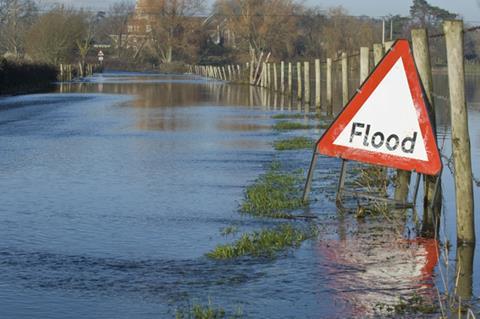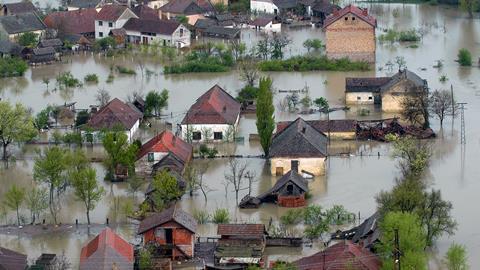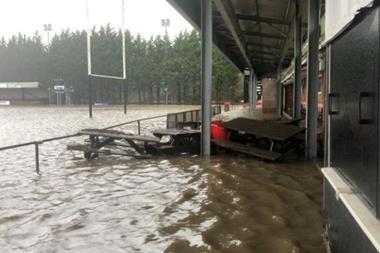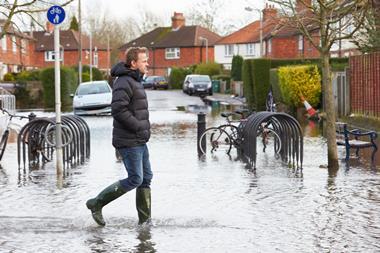UK annual flood losses have been estimated at £500m
Aviva has seen claims and calls surge by 285% this month compared to January.
The worst affected areas are Nottingham, Birmingham, Norwich and Bradford. It has caused chaos for travellers with many left stranded after their flights were cancelled.
It is using desk-based technology and its storm calculator to assess the damage, and at least 10% of customers have already made a claim via its online facility, with 12% already receiving payments.
The insurer has been providing its customers across the UK with emergency support as well as sharing advice and preventative measures through its website and social media channels.
It is urging customers to take precautions to protect their properties and vehicles with another storm potentially around the corner.
This follows Storm Ciara battering the UK over the weekend and Storm Dennis brewing.

Defra – the UK’s Department of Environment, Food and Rural Affairs revealed its cross-industry code of practice earlier this week. It estimates annual UK flood losses at £500m.
Whereas RMS has estimated that insured property losses from Storm Ciara will likely fall between 1.1 and 1.8bn euros. While it says that the storm is likely to be the ”first billion-Euro windstorm this season, it does not expect any post-evemy loss amplification and antcipates low business interruption losses.
Michèle Lai, product manager for Europe Climate Models at RMS, said that the storm is typically chracteristic of European windstorms, with low gusty winds.
Andrew Morrish, UK claims director for Aviva, said: “The majority of claims have been from people whose properties have been affected by strong winds, such as loose roof tiles, broken windows and fallen trees, but we are also starting to see flood claims.
”We are monitoring the situation closely, particularly where there are flood warnings in place.
“We have a network of suppliers who are already helping our customers – securing doors and windows for example – and our field consultants are out and about across the regions, speaking to our customers face-to-face.
”Our claims experts have already identified claims from vulnerable customers, and we are working with our network of suppliers to ensure these claims are given priority.”
Industry challenges
Sedgwick is also seeing a spike in claims within the high net worth span, small low-level floods around 150ml and deeper one metre floods – so it is drawing in all the UK loss adjuster’s expertise and resources across the business to deal with it effectively.
On top of this, the claims are coming from across the UK which means the logistics of the firm deploying its skills to localised areas across the country is tricky.
Sedgwick International UK’s national technical manager Ian Gibbs said that he was concerned about the recovery process and amount of damage like saturated ground with two storms running consecutively.
“The challenge SMEs face in high flood risk areas is that brokers will struggle to get insurance for people with flooding, all the premiums and excesses are going up.
”If you’re an insurer and a business [you insure] keeps getting flooded it’s very hard to keep insuring that business cost effectively as the losses are so great, so brokers will understandably find it difficult.
“I think the future is that businesses will need to understand how to minimise the impact of flooding, and work with their brokers [and loss adjusters] like Sedgwick to present the realistic risk that their business poses because of the work and the preparations that they have done.
”That will allow insurers to understand whether the risk has been greatly reduced by the measures and therefore find a type of cover that would work,” he said.
But he added that the ultimate challenge for the industry is trying to mitigate storms in close succession.
Uncertainty
Meanwhile Eyal Gluska, chief executive and co-founder at insurtech Setoo, said that to survive the uncertainty of the modern age, travel businesses must consider how they can improve experiences for travellers that are dealing with delays and cancellations, and offer solutions insurance that meet individual needs.
“Widely available travel insurance products are unclear in refunds for extreme weather protection, meaning passengers are facing uncertainty and disrupted travel with the additional stress of financial loss looming over them.
“Instead of opting for standard, one-size-fits-all, insurance, travel businesses should provide specialised, parametric protection that will automatically compensate consumers in the case of a flight delay or cancellation.
”These products remove the hassle of the claims process entirely, becoming a reliable tool to protect the travel experience and not just a necessary evil.”
Solution?
But could the solution be parametric insurance and flood warnings that are actionable?
Insurtech start-up – FloodFlash teamed up with Gallagher earlier this month to offer rapid pay-out insurance for businesses in areas of high-risk flooding.
“The partnership sees Gallagher being able to offer a new parametric flood insurance policy to its clients with claims settled on a pre-defined trigger point instead of through the traditional assessment of cost damages.
This means that when water depths exceed a chosen threshold, a pre-agreed settlement figure is paid out.
Meanwhile newly launched Previsico offers live actionable flood warnings in a bid to support insurers, brokers and customers in the UK. It claims that it could have saved the UK insurance industry at least £130m in the 2015-2016 floods.
Last Friday Previsico issued live flood alerts across the UK, using 3rd generation flood forecasting solution to provide accuarte, real-time property level flood forecasts.
Jonathan Jackson chief executive at the insurtech, said: ”Resilience needs to (and can) be more effective as extreme weather events increase. To be truly resilient you need to be prepared for an event with the right defences, flood action plans, and warning systems.
”Many people and organisations are now realising the need to improve their preparedness for flood events and are taking action, as evidenced by properly erected defences on the news this week.”
Previsico claims its role in providing warnings is helping to ensure that more people can protect their assets in time.
Jackson added that during claims surges insurers can struggle to properly investigate some claims but a warning system can help ease this.
Hosted by comedian and actor Tom Allen, 34 Gold, 23 Silver and 22 Bronze awards were handed out across an amazing 34 categories recognising brilliance and innovation right across the breadth of UK general insurance.






















































No comments yet